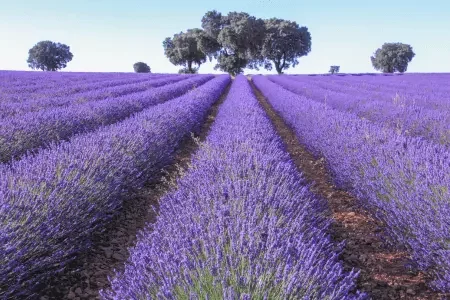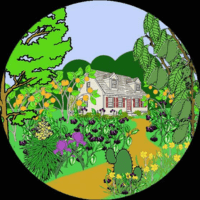Lavender (Lavandula) Plant
On this webpage: Learn about the Lavender plant, its history, how to grow Lavender, the species to choose and why, how to prune Lavender, culinary uses, medicinal qualities, and 15 Types of Lavender.
What is a Lavender Plant?
The Lavender plant is a culinary herb, an attractive floral plant, is known for it’s fragrance and oil, and is used medicinally. Lavandula is another common name for it. Lavender is native to Europe, East Africa, Southwest Asia, and India. Lavender is one of the most valuable herbs used since time immemorial.
The plant produces purple colored flowers. However, a few varieties have violet blue, rose, pale pink, white, and yellow colored flowers. They flower from spring to fall, depending on the species. They are a perennial plant and depending on your pant zone, are an evergreen. They need full sun and a well-draining soil for their best performance. They are very drought tolerance and are resistant to deer, rabbit and pests! Pollinators thrive on Lavender plants!!
Lavenders are a perfect candidate for hedging, bordering and rock gardens. However, they grow well in containers also. Almost all varieties are valued for its essential oils. It is widely used in cosmetics, perfumes, cleaning chemicals, air refreshers, insect repellents, aroma therapy and more. It’s in the Mint family. Some of the most common and widely cultivated Lavender varieties are below.

History of Lavender
Lavender has been used for 3,000 years.
- Egyptians used Lavender for cosmetics, fragrance and the mummification process.
- Ancient Greeks used it for fragrance. Theophrastus, the father of botany, described the healing qualities of scents. The ancient Greeks called Lavender nardus, after the Syrian city of Naarda.
- Romans believed in its antiseptic and medicinal properties. They also used it to deter insects and for fragrance. The name, Lavender can trace it’s roots to lavandārius, from lavanda (things to be washed). During the
- Victorian era, people of England used Lavender to perfume clothing and bed linens, as bathing was not a daily routine. Lavender oil production became an industry. It was also used to repel inspects, treat lice, as a perfume and a potpourri, in furniture polish and soap and as a cure-all in household medicine cupboards (Cache Creek Lavender). The English exported the oil around the world.
- Lavender was introduced to US in early 1600s.
More about the History of Lavender from Cache Creek Lavender Farm.
How to Grow Lavender
Grow Lavender plants in full sun, and well draining alkaline soil.
Site selection and Soil
- Lavender site selection. They require a sunny location. Give Lavender as much sun as possible. They do not grow well in shade. Secondly, plant them on a slope or raised bed if you’re in climate with regular rainfall.
- When to plant. Plant after the threat of frost has passed. It’s best to plant in spring, before hot summer or cold winter weather. For fall planting, use more established plants to ensure winter survival. Established plants include well-rooted plants from a 1-gallon pot or larger.
- Well draining soil.
- In climates with regular rainfall, Lavender plants will need well-draining soil. They are adapted to hot, dry, rocky or sandy soil.
Create a soil mix of sand, gravel and loam. Loam is nature’s mix of sand, silt and clay. Further, create “pore space” in your soil. “An ideal soil is … 45% mineral (sand, silt, and clay), 5% organic matter, and 50% pore space.” Therefore, perlite can be used, as well as sand and gravel.
Some course organic material is helpful but a high-level of organic soil is detrimental. Excessive organic material will retain too much water overwinter (ie, with snow on the ground). 5% course organic matter, according to experts! - In climates with little rainfall, Lavender plants will likely thrive. Well-draining soil is less important in dry conditions. The plant is adapted to dry climates. Finally, they tolerate poor to moderately fertile soil. So amending the soil is not a priority.
- In climates with regular rainfall, Lavender plants will need well-draining soil. They are adapted to hot, dry, rocky or sandy soil.
- Alkaline soil. Lavender plants’ native habitat includes limestone substrate. It is designed to grow in alkaline soil. So, while most plants tolerate a wide range of soil pH, Lavender plants do NOT grow well in acid soil.
Usually, soils are not very acidic or very alkaline, unless you live in an environment of limestone substrate (alkaline) or with old mature conifers (acidic), for example.
There are low-dollar soil testers and lime is used to increase alkaline levels for plants. We used Lime for our “alkaline leaning” Truffle Oak.
As an Amazon Associate, HEPPY earns from qualifying purchases (paid link). These are products WE use: Coarse Perlite | Fast Acting Lime | Ph Meter
Lavender plant care
Do not overwater or overfertilize Lavender plants. They are native to dry climates.
- Watering Lavender. Little or no water is required once they are established. Lavender are VERY drought resistant plants. Many are native in the HOT Mediterranean!
- Do not overwater Lavender plants. They do NOT like “wet feet.” Lavender plants will get root rot if they are overwatered, grown in high organic soil or soil that’s not well-draining.
- Fertilizing Lavender plants. Little fertilizer is needed. Potash fertilizer will encourage more flowering and improved flower color. How can I identify potash fertilizer? All fertilizers are identified by 3 numbers (for example, 10-10-10). Potash fertilizer is the last number (for example, 10-10-60).
- Pest control. Lavender plants are generally pest and disease free.
- Root rot. Moist or wet climates pose the greatest risk for root rot. Pythium, Phytophthora and Rhizoctonia are fungi or fungi-like microorganisms in the soil. Affected branches and plants must be removed and destroyed.
- Pruning. Prune Lavender plants annually if you want a compact appearance. Otherwise they sprawl and grow woody. Pruning also promotes a longer-lived plant. However, certain varieties are pruned differently. Lavender varieties and how to prune them is below!
HEPPY.org is a participant in the Amazon Services LLC Associates Program. As an Amazon Associate, HEPPY earns from qualifying purchases (paid link).





